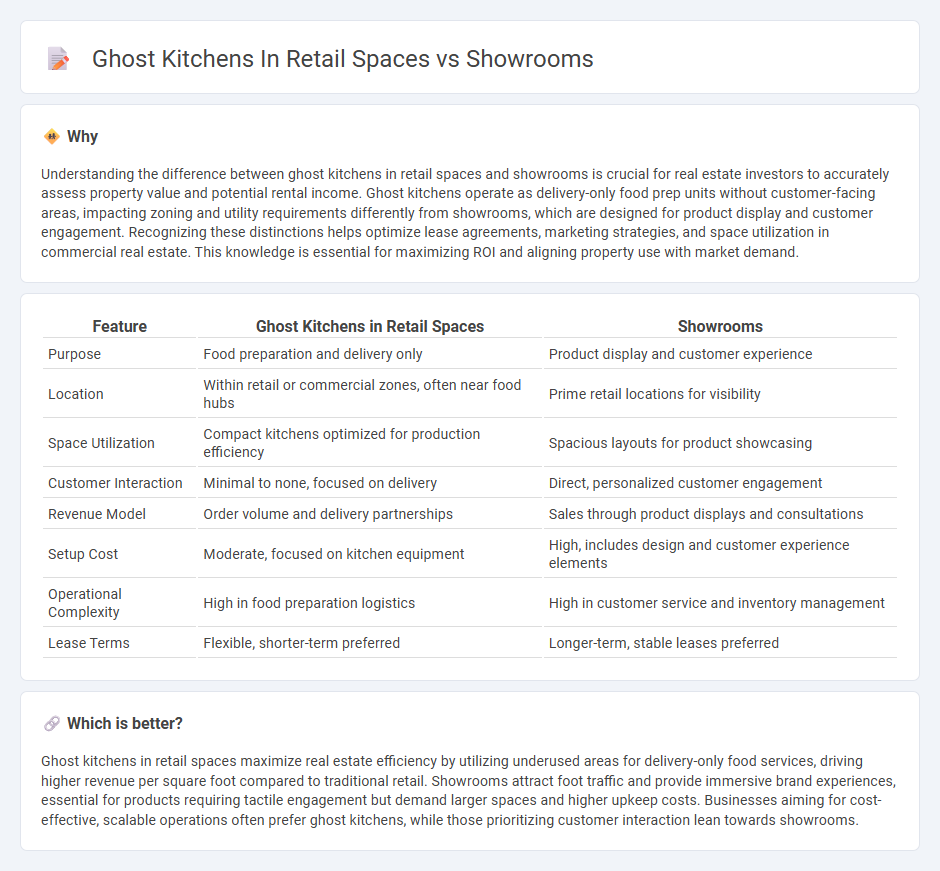
Ghost kitchens in retail spaces maximize underutilized real estate by converting areas into efficient food preparation hubs without dine-in facilities, enhancing revenue streams without the overhead of traditional restaurants. Showrooms function primarily as experiential spaces where customers engage with products directly, often requiring prime locations and ample foot traffic to drive sales. Explore how integrating ghost kitchens can redefine retail real estate strategies and profitability.
Why it is important
Understanding the difference between ghost kitchens in retail spaces and showrooms is crucial for real estate investors to accurately assess property value and potential rental income. Ghost kitchens operate as delivery-only food prep units without customer-facing areas, impacting zoning and utility requirements differently from showrooms, which are designed for product display and customer engagement. Recognizing these distinctions helps optimize lease agreements, marketing strategies, and space utilization in commercial real estate. This knowledge is essential for maximizing ROI and aligning property use with market demand.
Comparison Table
| Feature | Ghost Kitchens in Retail Spaces | Showrooms |
|---|---|---|
| Purpose | Food preparation and delivery only | Product display and customer experience |
| Location | Within retail or commercial zones, often near food hubs | Prime retail locations for visibility |
| Space Utilization | Compact kitchens optimized for production efficiency | Spacious layouts for product showcasing |
| Customer Interaction | Minimal to none, focused on delivery | Direct, personalized customer engagement |
| Revenue Model | Order volume and delivery partnerships | Sales through product displays and consultations |
| Setup Cost | Moderate, focused on kitchen equipment | High, includes design and customer experience elements |
| Operational Complexity | High in food preparation logistics | High in customer service and inventory management |
| Lease Terms | Flexible, shorter-term preferred | Longer-term, stable leases preferred |
Which is better?
Ghost kitchens in retail spaces maximize real estate efficiency by utilizing underused areas for delivery-only food services, driving higher revenue per square foot compared to traditional retail. Showrooms attract foot traffic and provide immersive brand experiences, essential for products requiring tactile engagement but demand larger spaces and higher upkeep costs. Businesses aiming for cost-effective, scalable operations often prefer ghost kitchens, while those prioritizing customer interaction lean towards showrooms.
Connection
Ghost kitchens in retail spaces and showrooms capitalize on underutilized square footage to generate additional revenue streams without disrupting core business operations. These virtual kitchens leverage existing infrastructure, enhancing real estate asset optimization by transforming non-traditional areas into profitable culinary hubs. The integration of ghost kitchens within retail real estate reflects a shift towards flexible, multifunctional property use that meets evolving consumer demand for convenience and experience.
Key Terms
Foot Traffic
Showrooms in retail spaces generate high foot traffic by offering interactive, tangible product experiences, which encourage direct purchases and brand engagement. In contrast, ghost kitchens operate without physical storefronts, relying on online orders and delivery, thus minimizing foot traffic but optimizing operational efficiency and reach. Explore how balancing these models can transform retail strategy and customer experience.
Operational Costs
Showrooms in retail spaces typically incur higher operational costs due to expenses like rent, utilities, and staffing, whereas ghost kitchens benefit from lower overhead by eliminating dine-in facilities and focusing solely on food preparation and delivery. The streamlined model of ghost kitchens reduces fixed costs and increases scalability, making them a cost-efficient solution for food businesses targeting e-commerce-driven markets. Explore deeper insights to understand which model aligns best with your operational budget and business goals.
Space Utilization
Showrooms optimize retail spaces by maximizing customer engagement through interactive product displays, driving higher foot traffic and conversion rates. Ghost kitchens utilize commercial real estate solely for food preparation and delivery, significantly reducing space requirements while increasing operational efficiency and scalability. Explore how these models reshape space utilization strategies in modern retail environments.
Source and External Links
Showroom - A showroom is a large space used to display products, such as automobiles, and is often found in prominent locations like the Champs Elysees and Merchandise Mart.
Sub-Zero, Wolf, and Cove Showrooms - These showrooms offer immersive kitchen inspiration with stunning appliances and bespoke kitchen design experiences across the United States.
Planar Showrooms - Planar offers various locations worldwide where visitors can experience display technology firsthand, helping find the best solutions for projects.
 dowidth.com
dowidth.com